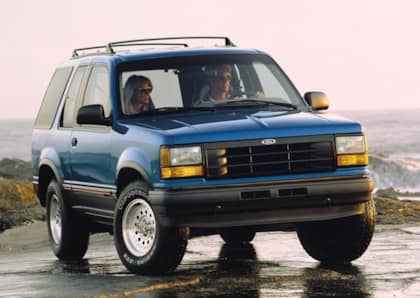The Suzuki Grand Vitara Is The Affordable 4x4 SUV You Never Knew Existed
Suzuki gained a foothold in American off-road circles in the '80s and '90s with a pair of pint-size 4x4s, first the two-door Samurai (the name given to the Jimny in the U.S. market), and then the somewhat larger two-door/four-door Sidekick (also sold as the Chevrolet/Geo Tracker), which eventually replaced it. Cheap, fun, and surprisingly nimble on the trail, these two SUVs never really broke through to the mainstream but managed to turn a decent profit.

At the end of the '90s Suzuki decided to make a stronger play for the families who were increasingly turning to sport-utility vehicles as their daily drivers. This meant taking the Sidekick slightly upscale, boosting its size a smidgen, and giving it a 'new for North America' name: the Vitara and the Grand Vitara.

The Grand Vitara might have been the most civilized Suzuki SUV to date, but that didn't meant it had left its Sidekick/Tracker roots entirely in the dust. In fact, the Grand Vitara and its smaller Vitara sibling continued to deliver the kind of off-road capability that was already disappearing from many of its similarly-sized sport-utility rivals, making it a stealth choice for modern day 4x4 fans seeking a cheap, under-the-radar rig.
Two Sizes, Three Engines
The Vitara name was a familiar one internationally, as it had been applied to various versions of the first-generation Sidekick in places as diverse as Australia, the UK, and Venezuela. In the United States, however, it provided the clean break that Suzuki was looking for, and the addition of 'Grand' on the badge indicated that the truck had grown in stature.

Starting in 1999, Suzuki's one-two SUV punch covered both the entry-level and the commuter set. The base two-door Vitara came with a 1.6L, 97hp four-cylinder engine, with an all-aluminum, 127hp 2.0L mill available for an extra charge (if you ordered the four-door version of the Vitara you got the larger motor standard).

The Suzuki Grand Vitara stepped up with a 2.5L, 155hp V6, a 24-valve design that was also good for 160 lb-ft of torque. Transmission choices included a five-speed manual and a four-speed automatic.

Suzuki was serious about pulling in fresh customers, and in addition to widening and lengthening its small sport-utilities it made sure to stack the Grand Vitara with an extensive (for the time) list of features.

That focus on comfort obscured the fact that the SUV's tight turning radius, good ground clearance, and rugged suspension kept it at the forefront of the off-road conversation among compact and subcompact trucks. Each and every version of the Vitara, Grand or otherwise, could be had with low-range four-wheel drive, a full-frame chassis, and coil springs front and rear, and two-door models offered a soft convertible top.
Last Of Its Kind
Right away, the Vitara and the Grand Vitara stood apart from soft-roaders like the Toyota RAV4 and the Honda CR-V, which relied on car-based unibody platforms that weren't nearly as tough. The flipside of this was an on-road character that was occasionally uncouth, which played a role in the Suzuki's modest sales. The market was shifting towards mall crawlers, and while the Grand Vitara was certainly a do-everything driver, it kept one foot in its rough-and-tumble past.

Suzuki held to tradition all the way until 2005, when the Grand Vitara was left standing as the only truly small body-on-frame SUVs still sold in the United States (the two-door Vitara had been dropped the year before). For 2006 the name would continue but the design would shift entirely in a unibody direction as the Grand Vitara joined the rest of the entry-level haulers with its sedan-derived platform.

It's important to note that during the Vitara/Grand Vitara's 1998-2005 run there were several similar vehicles available that borrowed bits from its parts bin. Chevrolet continued to build a Tracker using the Suzuki as its base, but early versions came exclusively with the 2.0L four-cylinder regardless of how many doors were ordered (with the V6 appearing in 2001). It lasted until 2004.

Suzuki also built a three-row SUV that stretched out the Grand Vitara's chassis starting 2001 and lasting until 2005. Called the XL-7, it came with a slightly larger V6 (2.7L, 170hp), and retained the same capabilities as the smaller Suzuki when pointed off-pavement (albeit with less impressive break-over angles).
Dare To Be Different, On A Budget
Why consider the Suzuki Vitara or Grand Vitara? The SUV occupies a unique spot among off-road vehicles of its era, smaller than stalwarts like the Pathfinder, Xterra, and the 4Runner, but more resilient and much more capable than the RAV4 and the Escape.

It also features solid Suzuki reliability, a decent community supporting it online, and inexpensive maintenance costs—provided you're ok with searching for parts, as the automaker folded its dealership network more than a decade ago.

The Grand Vitara offers particular appeal to anyone who feels frozen out by the recent surge in prices for '90s cute "utes" like the Samurai and the Sidekick. Why not skip the name recognition and snag a mightier, and just as rugged, version of the same and score a sizable discount to boot?











